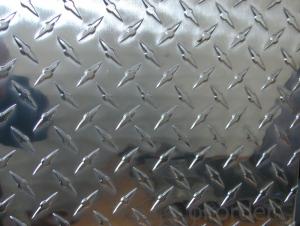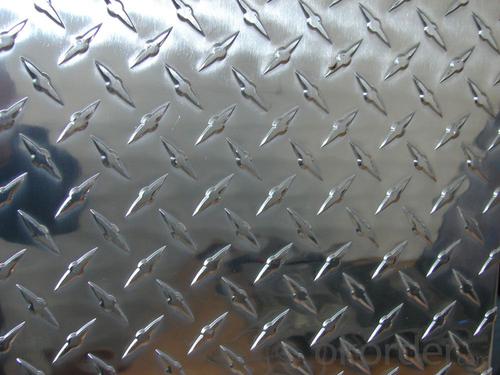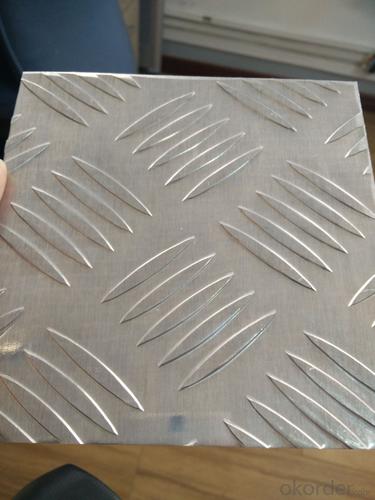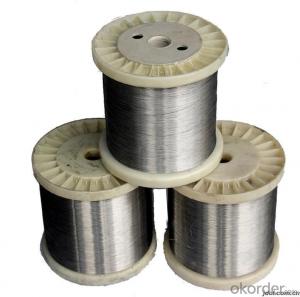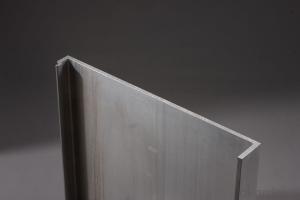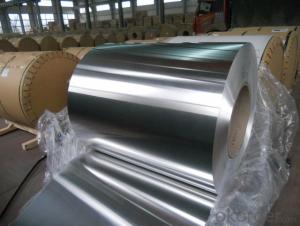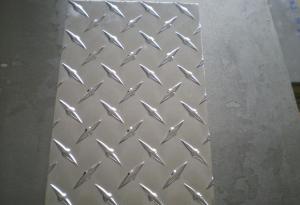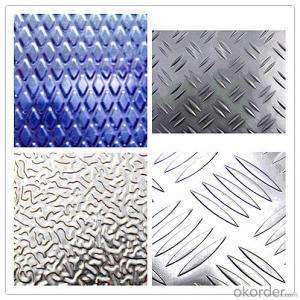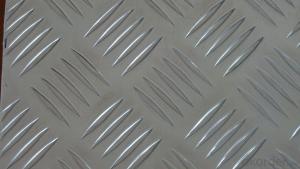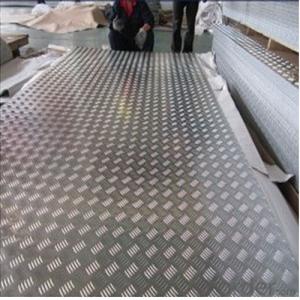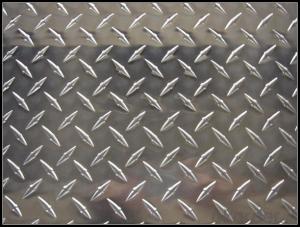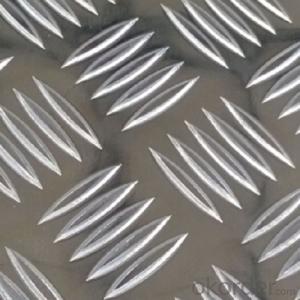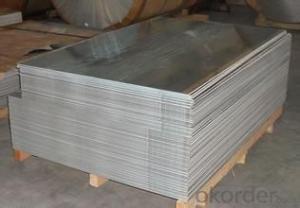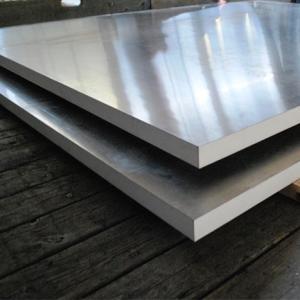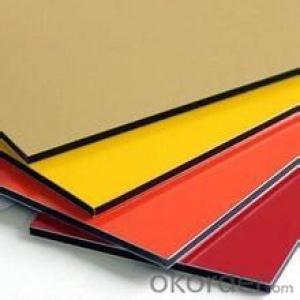Aluminum 1060 Sheets Treadplate (5 Bars/Diamond/Stucco)
- Loading Port:
- Shanghai
- Payment Terms:
- TT OR LC
- Min Order Qty:
- 5 m.t.
- Supply Capability:
- 100000 m.t./month
OKorder Service Pledge
OKorder Financial Service
You Might Also Like
Specification
Aluminium is a relatively soft, durable, lightweight,ductile and malleablemetalwith appearance ranging from silvery to dull gray, depending on the surfaceroughness. It is nonmagnetic and does not easily ignite. A fresh film ofaluminium serves as a good reflector (approximately 92%) of visible light and an excellent reflector(as much as 98%) of medium and far infrared radiation. The yield strengthof pure aluminium is 7–11 MPa, while aluminium alloys have yield strengthsranging from 200 MPa to 600 MPa. Aluminium has about one-third the density and stiffness of steel.It is easily machined, cast, drawnand extruded.
Aluminum coil/sheet have been used in the field of construcction and decoration(garage doors,ceiling etc.),electronic appliances,lignting decoration, air-condition air pipes,sandwichpanels and drainages etc.
1.Aluminum Treadplate(5 BARS/ DIAMOND/STUCCO) :
Aluminum Treadplate is widely used for decorative purposes in construction, and builing. Aluminum Treadplate is also very commonly used for anti-shippery purposes in vehicles and pulic places.
2. Specification of Aluminum Treadplate(5 BARS/ DIAMOND/STUCCO)
Alloy: 1XXX,3XXX,5XXX
Temper: H14, H16, H18, H22, H24, H26, H32, O/F
Thickness: 1mm-4mm
Width: 800Mm-1500mm
3. Aluminum Treadplate(5 BARS/ DIAMOND/STUCCO)

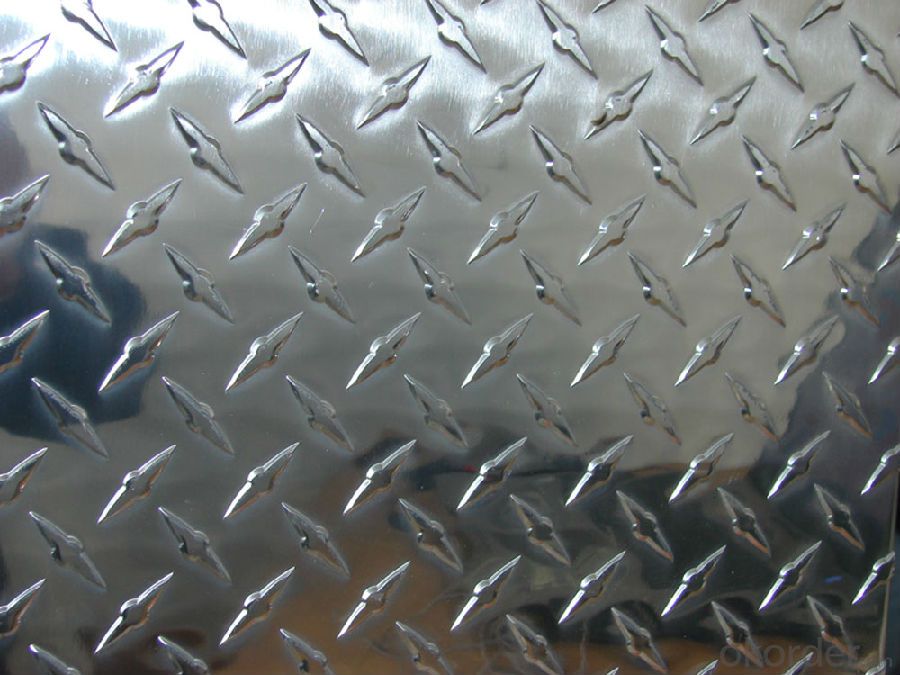
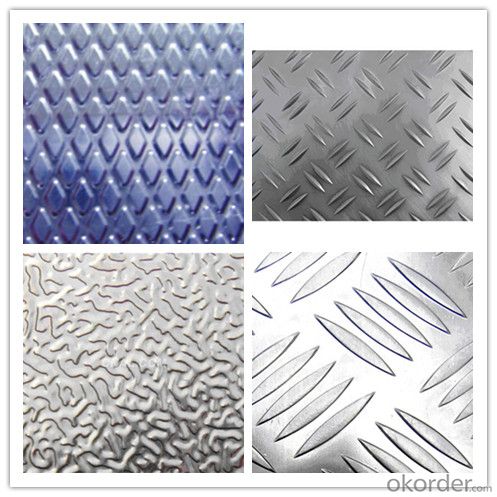
4 Our Advantages
1. Excellent quality of products
2. Quick delivery
3. Best service to clients
4. BV,SGS avalible
5. No buckle o waveness
6. Tension leveling
7. Certificate of Origin
8. FormeA,E
- Q: Are aluminum sheets suitable for beverage cans?
- Yes, aluminum sheets are suitable for beverage cans. Aluminum is a widely used material in the beverage industry due to its unique properties. It is lightweight, corrosion-resistant, and provides an excellent barrier against light, oxygen, and moisture, which helps to preserve the quality and freshness of the beverage. Additionally, aluminum is easily formable, allowing for the production of various can shapes and sizes. It is also recyclable, making it an environmentally friendly choice. Overall, aluminum sheets are an ideal material for beverage cans, meeting both functional and sustainability requirements.
- Q: Can aluminum sheets be used in food packaging?
- Yes, aluminum sheets can be and are commonly used in food packaging. Aluminum is a popular choice for food packaging due to its excellent barrier properties, which protect the food from light, oxygen, moisture, and other external factors that can spoil or contaminate it. Aluminum sheets are lightweight, durable, and resistant to corrosion, making them suitable for various types of food packaging, such as foil wraps, containers, trays, and pouches. Additionally, aluminum is a recyclable material, making it an environmentally friendly choice for food packaging.
- Q: Explain the impact of aluminum sheets on the thermal insulation of a building.
- <p>Aluminum sheets, due to their high thermal conductivity, can significantly reduce the thermal insulation of a building. They allow heat to transfer easily through them, which can lead to increased heat loss in winter and heat gain in summer. This can result in higher energy consumption for heating and cooling, making the building less energy-efficient. However, when used in combination with proper insulation materials and techniques, aluminum sheets can still be part of an effective building envelope, provided their thermal bridging effects are mitigated.</p>
- Q: Are aluminum sheets suitable for electrical bus bars?
- Certain applications may find aluminum sheets suitable for use in electrical bus bars. Aluminum possesses several properties that make it a viable choice for bus bars. Firstly, aluminum is a lightweight material, which can be advantageous in situations where weight reduction is crucial. Furthermore, aluminum exhibits good electrical conductivity, although it falls short of copper in terms of conductivity. Nevertheless, aluminum bus bars can still handle high electrical currents and are commonly employed in power distribution systems. However, one drawback of aluminum bus bars is their higher resistance compared to copper bus bars. Consequently, they have a tendency to generate more heat, particularly under heavy current loads. To address this issue, aluminum bus bars are often designed with larger cross-sectional areas to minimize resistance and dissipate heat more effectively. Another challenge associated with aluminum bus bars is their vulnerability to oxidation and corrosion. This concern can be tackled by applying protective coatings or utilizing alloys that offer superior corrosion resistance. Additionally, it is crucial to ensure proper insulation and avoid contact with dissimilar metals to prevent galvanic corrosion. In conclusion, aluminum sheets can serve as suitable materials for electrical bus bars, particularly in scenarios where weight reduction is a priority. However, careful consideration must be given to factors such as electrical conductivity, heat dissipation, and corrosion resistance to ensure optimal performance and longevity of the bus bars.
- Q: How do you cut aluminum sheets?
- There are various methods available for cutting aluminum sheets, depending on their thickness and size. Here, we will discuss some commonly used techniques: 1. Hand shears prove effective for thin aluminum sheets. These handheld tools feature sharp blades that can cut through the sheet by applying manual force. 2. For thicker aluminum sheets, power shears are a better option. These tools, either electric or pneumatic, have powerful blades that can effortlessly cut through the material. They are particularly useful for straight cuts. 3. When it comes to making curved or irregular cuts, a jigsaw with a metal-cutting blade comes in handy. Ensure you use a blade specifically designed for cutting metal. 4. Another method is using a circular saw with a carbide-tipped blade. This technique works well for straight cuts; however, it is crucial to securely clamp the sheet to avoid vibrations during cutting. 5. For precise shapes and sizes, Computer Numerical Control (CNC) machines are ideal. These machines utilize computer programs to control the cutting process, making them suitable for complex or repetitive cuts. Before cutting aluminum sheets, it is essential to prioritize safety. Wear appropriate gear such as gloves and safety glasses to protect yourself from sharp edges or metal shavings. Additionally, secure the sheet firmly in place using clamps or a vise to prevent any movement during cutting.
- Q: Can the aluminum sheets be used for manufacturing audio amplifier cases?
- Yes, aluminum sheets can be used for manufacturing audio amplifier cases. Aluminum is a commonly used material in the manufacturing of electronic equipment due to its lightweight, durability, and excellent heat dissipation properties.
- Q: Are aluminum sheets fire resistant?
- In reality, fire resistance characterizes aluminum sheets. With a high melting point and difficulty in igniting or burning, aluminum emerges as a non-combustible substance that hinders fire propagation. Consequently, aluminum sheets find extensive utilization in sectors like construction and aerospace, where fire resistance assumes paramount importance. Nevertheless, it is crucial to acknowledge that although aluminum inherently possesses fire resistance, the materials or substances affixed to or in contact with the aluminum sheet might lack such properties.
- Q: What are the potential safety issues associated with the use of aluminum sheets?
- <p>Aluminum sheets are generally safe to use, but there are a few considerations. They can be sharp when cut, so proper handling is important to avoid cuts. Aluminum is a good conductor of heat, so care should be taken to avoid burns when handling hot aluminum sheets. Additionally, inhalation of aluminum dust can be harmful, so it's important to work in a well-ventilated area or use a dust mask when cutting or grinding aluminum. In terms of long-term health, there's ongoing debate about the safety of aluminum exposure, but it's generally considered safe when used in accordance with proper safety measures.</p>
- Q: Are aluminum sheets suitable for food contact applications?
- Aluminum sheets are indeed appropriate for food contact purposes. The food industry extensively employs aluminum because of its diverse advantageous characteristics. It is non-hazardous, non-responsive, and resistant to corrosion, thereby ensuring that it is safe to use alongside food. Aluminum sheets can be effortlessly molded into various shapes and sizes, rendering them suitable for a broad array of food packaging and cooking uses. Moreover, aluminum boasts exceptional thermal conductivity, facilitating efficient heat transfer during the cooking or baking process. It is also impervious to light, moisture, and oxygen, creating a protective barrier that preserves the freshness and quality of food. In general, due to their safety, adaptability, and durability, aluminum sheets are a highly favored option for food contact applications.
- Q: This question asks for a list of various standard sizes of aluminum sheets that are commonly available in the market.
- <p>Aluminum sheet sizes can vary widely depending on the application and industry standards. Commonly available sizes include 1/8 inch, 1/4 inch, 3/8 inch, and 1/2 inch thicknesses, with widths ranging from 12 inches to 60 inches. Lengths can be from 4 feet to 20 feet or more. However, specific sizes can differ based on regional standards and manufacturers' offerings. It's also important to note that custom sizes can be ordered to meet specific project requirements. Always check with suppliers for the most current and detailed list of available sizes.</p>
Send your message to us
Aluminum 1060 Sheets Treadplate (5 Bars/Diamond/Stucco)
- Loading Port:
- Shanghai
- Payment Terms:
- TT OR LC
- Min Order Qty:
- 5 m.t.
- Supply Capability:
- 100000 m.t./month
OKorder Service Pledge
OKorder Financial Service
Similar products
Hot products
Hot Searches
Related keywords
